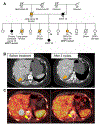Whole-exome sequencing reveals germline-mutated small cell lung cancer subtype with favorable response to DNA repair-targeted therapies
- PMID: 33504652
- PMCID: PMC8489678
- DOI: 10.1126/scitranslmed.abc7488
Whole-exome sequencing reveals germline-mutated small cell lung cancer subtype with favorable response to DNA repair-targeted therapies
Erratum in
-
Erratum for Research Article "Whole-exome sequencing reveals germline-mutated small cell lung cancer subtype with favorable response to DNA repair-targeted therapies" by C. Tlemsani, N. Takahashi, L. Pongor, V. N. Rajapakse, M. Tyagi, X. Wen, G.-A. Fasaye, K. T. Schmidt, P. Desai, C. Kim, A. Rajan, S. Swift, L. Sciuto, R. Vilimas, S. Webb, S. Nichols, W. D. Figg, Y. Pommier, K. Calzone, S. M. Steinberg, J. S. Wei, U. Guha, C. E. Turner, J. Khan, A. Thomas.Sci Transl Med. 2021 Oct 13;13(615):eabm6064. doi: 10.1126/scitranslmed.abm6064. Epub 2021 Oct 13. Sci Transl Med. 2021. PMID: 34644151 No abstract available.
Abstract
Because tobacco is a potent carcinogen, secondary causes of lung cancer are often diminished in perceived importance. To assess the extent of inherited susceptibility to small cell lung cancer (SCLC), the most lethal type of lung cancer, we sequenced germline exomes of 87 patients (77 SCLC and 10 extrapulmonary small cell) and considered 607 genes, discovering 42 deleterious variants in 35 cancer-predisposition genes among 43.7% of patients. These findings were validated in an independent cohort of 79 patients with SCLC. Loss of heterozygosity was observed in 3 of 14 (21.4%) tumors. Identification of variants influenced medical management and family member testing in nine (10.3%) patients. Unselected patients with SCLC were more likely to carry germline RAD51 paralog D (RAD51D), checkpoint kinase 1 (CHEK1), breast cancer 2 (BRCA2), and mutY DNA glycosylase (MUTYH) pathogenic variants than healthy controls. Germline genotype was significantly associated with the likelihood of a first-degree relative with cancer or lung cancer (odds ratio: 1.82, P = 0.008; and 2.60, P = 0.028), and longer recurrence-free survival after platinum-based chemotherapy (P = 0.002), independent of known prognostic factors. Treatment of a patient with relapsed SCLC and germline pathogenic mutation of BRCA1 interacting protein C-terminal helicase 1 (BRIP1), a homologous recombination-related gene, using agents synthetically lethal with homologous recombination deficiency, resulted in a notable disease response. This work demonstrates that SCLC, currently thought to result almost exclusively from tobacco exposure, may have an inherited predisposition and lays the groundwork for targeted therapies based on the genes involved.
Copyright © 2021 The Authors, some rights reserved; exclusive licensee American Association for the Advancement of Science. No claim to original U.S. Government Works.
Figures






References
-
- Bray F, Ferlay J, Soerjomataram I, Siegel RL, Torre LA, Jemal A, Global cancer statistics 2018: GLOBOCAN estimates of incidence and mortality worldwide for 36 cancers in 185 countries. CA Cancer J. Clin 68, 394–424 (2018). - PubMed
-
- Govindan R, Page N, Morgensztern D, Read W, Tierney R, Vlahiotis A, Spitznagel EL, Piccirillo J, Changing epidemiology of small-cell lung cancer in the United States over the last 30 years: Analysis of the surveillance, epidemiologic, and end results database. J. Clin. Oncol 24, 4539–4544 (2006). - PubMed
Publication types
MeSH terms
Substances
Grants and funding
LinkOut - more resources
Full Text Sources
Other Literature Sources
Medical
Research Materials
Miscellaneous

